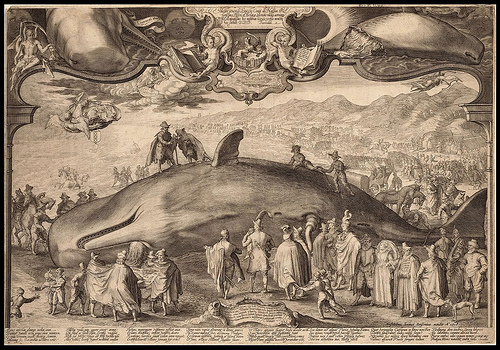Saenredam’s engraving records in Latin the whale’s measurements: 60 feet long by 14 feet high, with a circumference of 36 feet, the flukes 14 feet wide and the lower jaw of 12 feet long. That’s the uppermost known size of sperm whales. In life, he might have weighed some 60 tons.
The state of the tongue in this picture indicates the sperm whale was probably dead before beaching.
The small inset view of the dead whale also shows the peeled skin characteristic of the work of killer whales.
The whale wears what looks like a tow line around his tailstock. So maybe some townspeople rowed him ashore. Or are they planning to row him offshore (since he appears to be getting stinky already)? Seems like the two men behind the tailstock are taking the measurements. Maybe they’re planning to divvy the whale up. Even if the meat’s rotting, it would be of value to, say, swine farmers. The spermaceti oil alone would provide a huge windfall for the town—or whoever “owned” the carcass. Would love to know how they worked that out. A large bull sperm whale might possess three tons of waxy spermaceti. Here’s some of what I wrote about that in Deep Blue Home:
This was the treasure lusted after by whalemen of old, an elixir for nineteenth-century medicine and technology as ubiquitous as petroleum products are today and used for many of the same purposes: lubricants and rust-proofing in watches, lenses, and scientific instruments; oils for transmissions and engines; waxy elements in lotions, ointments, glycerines, pomades, detergents; as well as additives to vitamins and medicinal compounds. Spermaceti was, in the words of the eminent whale researchers Hal Whitehead and Linda Weilgart of Dalhousie University, Nova Scotia, the oil that lubricated the Industrial Revolution.[i] It was also the finest fuel for candles and such a standard of its day that candlepower—once an official unit of illumination—was calibrated against the light emitted in the course of an hour by burning a spermaceti candle.

Meanwhile, these two jaunty fellows are arriving on scene with a flensing knife, ready to disassemble the remains.
According to BibliOddyssey (warning: prepare to disappear down an absorbing blogger-hole), Saenredam’s engraving is actually a disaster allegory:
This elaborate illustration… belongs to a narrow genre of disaster allegories—of which Saenredam’s print is perhaps the finest example—that found a receptive audience, chiefly in the 17th century. Beached whales were regarded as significant… because beachings were a part of the folklore, seen as bad omens and associated with disasters and tragedies… In a series of slightly obscure vignettes, Saenredam alludes to other circumstances that are associated with or thought to be attributable to the whale’s appearance on the coast. In the far background we have both solar and lunar eclipses which occurred shortly after the whale’s appearance and, like comets and other irregularly occurring natural phenomena, were seen by contemporary observers as harbingers of doom. An unhappy face has been caricatured onto the moon(s). An angel bearing the coat of arms of Amsterdam, watched over by the ominous looking father time, is shot by death and falls from the sky, and may represent the epidemic of plague fatalities in the capital in the first couple of years of the 17th century. In the cartouche below the lion, the cartographic wind symbol can be seen blowing the land away in reference to an earthquake that occurred at the beginning of 1602.
The Latin verse at the foot of the print is by the Dutch poet Dirk Schrevel. I’ve started to work through a Google translation but it’s going to take me a while. If you want to explore this image further, there’s a high-resolution zoomable view of it at Beeldebank.
For a modern image of a sperm whale, complete with radically evolved thinking since 1601, check out this video of Bryant Austin‘s powerful work.
Trailer: In the Eye of the Whale from MMCTA on Vimeo.
[i] From Whitehead‘s and Weilgart’s, The Sperm Whale: Social Females and Roving Males, in Cetacean Societies: Field Studies of Whales and Dolphins, edited by Janet Mann, et al. ISBN: 9780226503417.




















